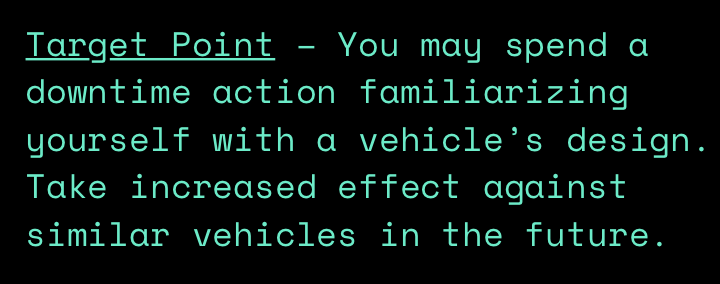Here& #39;s a quick breakdown of the way that I& #39;m approaching playbooks now, and how I used that to write the Giantkiller. It was useful to me to think of a playbook as an interrogation of an ethical question, and everything in the playbook as methods of complicating that question.
For many games it& #39;s easy for playbooks/classes to become about answers. The GM puts problems in front of you and your playbook becomes the verbs you use to solve those problems with out raising any questions on its own. I wanted a playbook where nothing was a neat solution.
I state the central question in this screenshot of ethics section of the playbook. From here it would have been easy for me to simply say "and this playbook is the answer". I didn& #39;t want that. I wanted you to have to grapple with what even asking this question meant to the world.
Each piece of gear and move becomes a vector for interrogation and complication. An example is the Anti-Mech blade. The blade was my way of giving the players tools to face down war machines, making it lethal was a way to highlight the consequences of targeting vehicles.
If your answer to thew question "How do I pushback against the mechanization of war?" is "develop weapons to take down war machines" then its an interesting secondary question to ask "what happens when you then need to face a human?"
Another example: This move solves a few mechanical problems for me. It helps me put the giantkiller on firm footing against vehicles, it simulates learning over the course of campaigns, and it fill the space of downtime options that are lost without a vehicle.
But it also forces the player to ask questions about what kind of mechs they are facing and to examine the design principles and production lines in the game world. I wanted to push the player/GM towards really engaging with the physicality and details of the mechs they face.
Finding ways to ask mechanical questions was super easy because @Notaninn has put such elegant and tightly designed mechanical levers into Beam Saber. He was also kind enough to provide me a neat list to pull from so that I could make sure I used a variety of them.
A friend ( @essivecase  https://abs.twimg.com/emoji/v2/... draggable="false" alt="👋" title="Waving hand" aria-label="Emoji: Waving hand">) brought up to me the fact that playbooks/classes are often missing t scaffolding to help players figure out what kind of plots will show case this character best, what questions you should be asking not just at character creation but in play.
https://abs.twimg.com/emoji/v2/... draggable="false" alt="👋" title="Waving hand" aria-label="Emoji: Waving hand">) brought up to me the fact that playbooks/classes are often missing t scaffolding to help players figure out what kind of plots will show case this character best, what questions you should be asking not just at character creation but in play.
I wanted to take that a step farther, making moves that make the loop of finding questions to push plot forward automatic and give mechanical handholds for finding ways to explore the core question the game and playbook. Solve x problem x with y move, then have z questions.
I think a playbook that is only about offering ways to solve problems fails people because everything becomes a problem to get out of and because it puts the onus of finding new problems/new questions to drive plot the gm and players with out much mechanical help.
Playbooks can be ABOUT something. They can be tools of exploration but you gotta make sure that that exploration is actually supported by the structure so its not only on players to build and advocate for the kind of plots that while showcase their character.
If this thread interested you, you should check out the full playbook here: https://roswellian.itch.io/the-giantkiller-playbook">https://roswellian.itch.io/the-giant...
And @Notaninn& #39;s Beam Saber here: https://austin-ramsay.itch.io/beamsaber ">https://austin-ramsay.itch.io/beamsaber...
And @Notaninn& #39;s Beam Saber here: https://austin-ramsay.itch.io/beamsaber ">https://austin-ramsay.itch.io/beamsaber...
You should also follow @SeaExcursion who did the art and playtesting who was instrumental in me coming around to this approach. And @abemendes who crystalized a lot of this thinking for me!!
If you like this thread you should also check out @SeaExcursion’s thread in the art process behind this playbook: https://twitter.com/seaexcursion/status/1285276045038325762?s=21">https://twitter.com/seaexcurs... https://twitter.com/seaexcursion/status/1285276045038325762">https://twitter.com/seaexcurs...

 Read on Twitter
Read on Twitter




